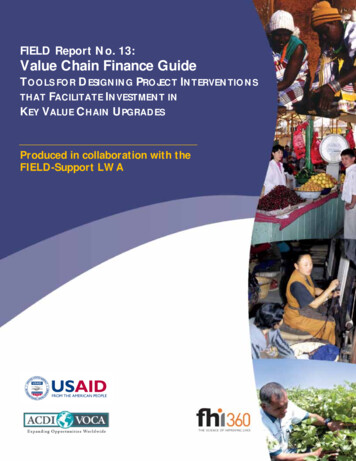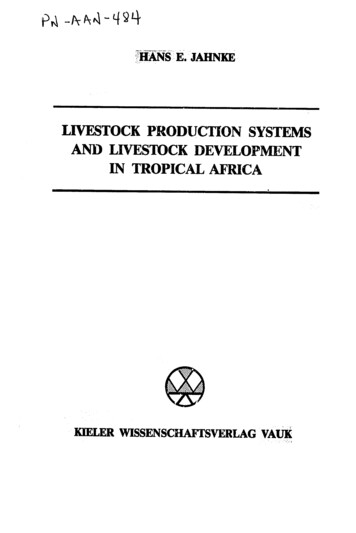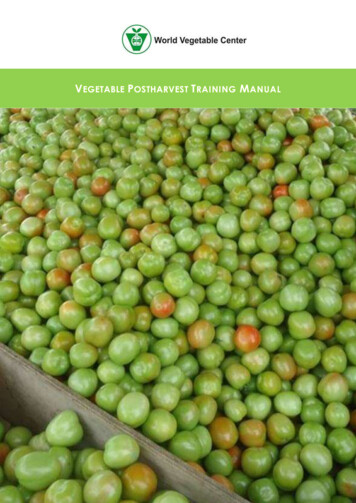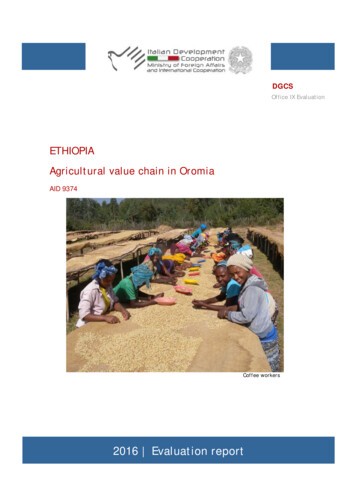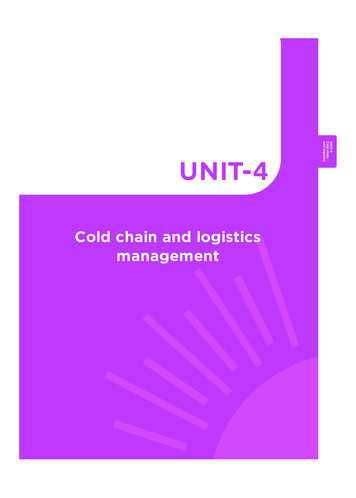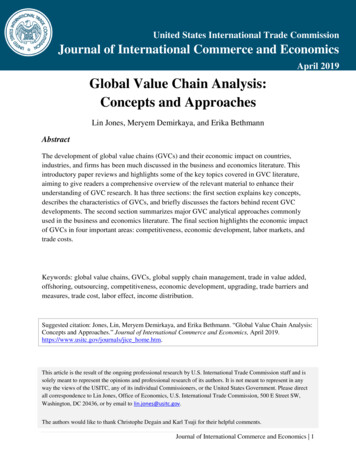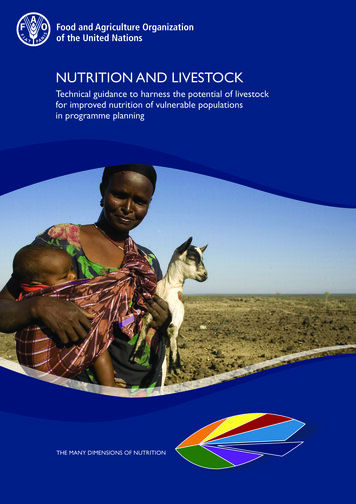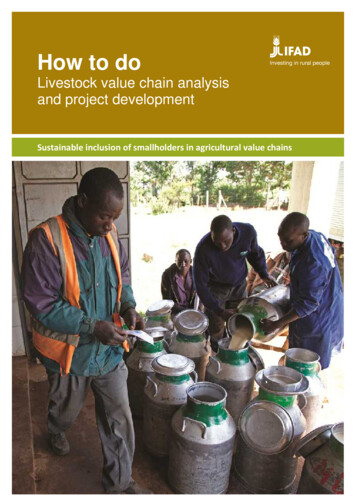
Transcription
How to doLivestock value chain analysisand project developmentSustainable inclusion of smallholders in agricultural value chains
How To Do Notes are prepared by the IFAD Policy and Technical Advisory Division andprovide practical suggestions and guidelines for country programme managers, project designteams and implementing partners to help them design and implement programmes andprojects.They present technical and practical aspects of specific approaches, methodologies, modelsand project components that have been tested and can be recommended for implementationand scaling up. The notes include best practices and case studies that can be used as modelsin their particular thematic areas.How To Do Notes provide tools for project design based on best practices collected at thefield level. They guide teams on how to implement specific recommendations of IFAD’soperational policies, standard project requirements and financing tools.The How To Do Notes are “living” documents and will be updated periodically based on newexperiences and feedback. If you have any comments or suggestions, please contact theoriginators.OriginatorAntonio RotaLead Technical Specialist, LivestockPolicy and Technical Advisory DivisionE-mail: a.rota@ifad.orgAcknowledgementsThe originator wishes to acknowledge the substantive technical support and contributions receivedfrom Philipp Baumgartner, Don Greenberg and Monica Romano. The technical guidance ofMarco Camagni and Mylene Kherallah is also acknowledged. Thanks also go to the peer reviewers:Michael Hamp, Ed Heinemann, Norman Messer, Henning Pedersen and Claus Reiner.Maria-Elena Mangiafico provided editorial, presentation and overall coordination support throughoutthe publication process.ContactMaria-Elena MangiaficoKnowledge Management and Grants OfficerPolicy and Technical Advisory DivisionE-mail: m.mangiafico@ifad.orgJanuary 2016Cover photo: IFAD/Susan BeccioKenya - Smallholder Dairy Commercialization Programme
ContentsList of acronyms.iiIntroduction.1A step-by-step approach to value chain analysis and project design.3Development of the value chain concept . 3Value chain analysis . 7Initial project design. 20Final project design and quality assurance . 25Concluding remarks .26References and further reading .27i
List of acronymsiiAIartificial inseminationCOSOPcountry strategic opportunities programmeEUEuropean UnionFFSfarmer field schoolIPinnovation platformLITSlivestock identification and traceability systemLPGlivestock producer groupsMFImicrofinance institutionPPPPpublic-private-producer partnershipR&Dresearch and developmentVCvalue chain
How to do livestock value chain analysis and project developmentIntroductionMost newly designed projects at IFAD are value chain (VC) projects, or at least use a VC approach toachieve core objectives. Projects in the livestock sector are no exception.Livestock contributes to the livelihoods and food security of about 1 billion people around the world,particularly the rural poor in developing countries. Livestock accounts for more than 30 per cent of theagricultural GDP of developing countries and for between2 and more than 33 per cent of household income. Forexample, beef production and marketing support 70 millionUsing this How To Do Notepeople in West Africa; dairy supports 124 million people inThis livestock value chain note is part ofSouth Asia and 24 million in East Africa; and small ruminantthe Commodity Value Chain Toolkit. Theproduction supports 81 million people in West Africa andnote focuses on livestock-specific issuesand examples. For more general28 million in Southern Africa.1Demand, especially for edible livestock products, hasincreased as a result of growth in domestic consumption andexports and is predicted to more than double in 20 years. Theemergence of the modern retail sector has led to higherstandards for meat and dairy products in increasingly largeparts of the world.guidance on the design andimplementation of value chaindevelopment projects please refer to:Camagni and Kherallah, 2014http://www.ifad.org/knotes/valuechain/vc howto.pdfWith the right approach, supplying this growing demand can be a pathway out of poverty, especially forsmall-scale livestock keepers at the upper and middle levels of the pyramid,2 provided that they areorganized and have access to the necessary inputs, services and finance. Livestock keepers at the bottomof the pyramid, and even landless people, can also participate in livestock VCs as service providers, feedsuppliers or simply workers.A thriving livestock VC supports other agricultural VCs, as it “pulls” demand from the small-scale cropproducers who grow fodder crops or supply crop residues to livestock producers.What is a value chain? A VC is the pathway of processes that a product follows as it moves from theprimary producer to the final consumer. In principle at least, value is added at each stage of the chain,hence the term “value chain”. Value addition is determined by the market and is not necessarily increasedby processing or physical transformation. For example, a VC for fresh, open-range, organic beef with littlephysical transformation can generate greater value for the farmer (and other VC actors) than a VC forhighly processed beef sausage.VCs are “meso-level” structures in that they fall between the macro-level of the economy and the microlevel of individual livestock producers. VCs can be defined quite narrowly, such as “the VC for 1-litre tubs ofyogurt in the Republic of Moldova”, or very broadly, such as “the beef livestock VC in Botswana”.Livestock VCs can be short and quite simple, such as the VC followed by a bucket of milk from a farmer’scow that is sold to the farmer’s neighbour, or they can be quite long and complex, such as the VC from asmall-scale Angora goat keeper in Lesotho to a mohair sweater sold in Europe. Figure 1 maps a VC formohair sweaters.1Herrero, M., D. Grace, J. Njuki, N. Johnson, D. Enahoro, S. Silvestri, and M.C. Rufino. 2013. The roles of livestock in developing countries. Animal, 7(s1):3-18; Staal S., J. Poole, I. Baltenweck, J. Mwacharo, A. Notenbaert, T. Randolph, W. Thorpe, J. Nzuma, and M. Herrero. 2009. Targeting strategicinvestment in livestock development as a vehicle for rural livelihoods. Bill & Melinda Gates Foundation (BMGF) and International Livestock Research Institute(ILRI) Knowledge Generation Project. Nairobi, Kenya: International Livestock Research Institute (ILRI).2This typology is adapted from Vorley B., L. Cotula, and M.-K. Chan. 2012. Tipping the Balance: Policies to shape agricultural investments and markets infavour of small-scale farmers. Oxford, United Kingdom: Oxfam International.1
How to do livestock value chain analysis and project developmentSource: IFAD (2014)Figure 1: Mohair sweater value chainA VC map is a simplified representation of a complex and dynamic reality. The inputs and services that gointo each step of the VC, and the enabling environment that affects the VC, cannot easily be shown on aVC map but are vitally important. Key inputs and services include feed, veterinary drugs and services,extension advice, market information and finance.Key elements in an enabling environment include: the institutional, policy, legal and business environment – access to grazing land, licensingrestrictions on para-veterinarians, etc. cultural, social, religious and gender-based systems and practices – control of cash from animalproducts, etc. rural infrastructure – delineated stock routes, watering holes, etc.IFAD’s livestock VC projects are designed to be inclusive and pro-poor. That is, they seek to upgrade andimprove the efficiency of VCs primarily to benefit IFAD’s target groups – small-scale livestock keepers andthe rural poor. Through successful VC projects, these target groups become more dynamic actors in theVC and benefit from: higher income levels more stable income streams throughout the year greater resilience to shocks induced by weather, disease or market fluctuations.The position of small-scale livestock keepers can be improved through various upgrading strategies:2 Product and process upgrading aims at “doing things better and/or bigger” and includesenhancing the efficiency of production processes and the quality of products to comply withbuyers’ requirements. For example, a poultry keeper may use improved feed formulation andvaccinate her birds to produce more eggs per bird. A dairy farmer can avoid adulteration practicesor can chill milk immediately after milking to produce a higher-grade product. These interventionsfocus on the production stage. Functional upgrading involves producing new goods or services either upstream or downstreamin the VC. Examples of upstream interventions include livestock keepers producing high-qualitylucerne as fodder for their animals or for sale. Downstream, farmers may make yogurt from theraw milk. Another form of functional upgrading occurs when farmers involved in a VC enter anotherclosely related one, such as when egg producers expand their activities to produce broilers.
How to do livestock value chain analysis and project development Upgrading of coordination and business models often implies helping to formalize and makemore transparent (through contracts) both the horizontal relationships among livestock farmers inthe same VC segment, such as among the different groups of dairy farmers who sell to a singlecooperative, and the vertical relationships between actors in different VC segments, such asbetween dairy farmers and a milk processor.In all cases, upgrading should be in response to a clearly identified market opportunity that promises apositive return on investment, such as cattle fattening in IFAD-funded projects in Lao People’s DemocraticRepublic, Swaziland and Viet Nam. In all cases, upgrading projects must work with livestock keepers whoare willing and able to move from subsistence livelihood strategies to commercial production.A step-by-step approach to value chain analysis andproject designThe step-by-step approach to VC analysis and project design follows the basic IFAD project design cycle.Each step is briefly described and followed by guiding questions for the project design team. The VCapproach should be adopted early in the project cycle, such as when developing project concept notes fora country strategic opportunities programme (COSOP).In practice, the timing of VC project design often depends on the results of earlier projects, the ongoingrelationship between IFAD and the host government, the experience of other development partners in thelivestock sector, etc. Even when a project is already being implemented, a VC analysis can help inform andstrengthen existing activities and identify new partners and activities for better achieving project goals.For many VCs in many countries, there is already a great deal of published information from projects andthe government. This information should be analysed first so that the design team can focus its primaryresearch and fieldwork on areas where there are gaps or the need for updated information.Development of the value chain conceptStep 1: Preliminary assessment of livestock systemsDuring the preliminary assessment, background information on the livestock sector or subsector isgathered from the country, provincial and/or district levels – depending on the project and country context(Box 1). The data are used to: develop a shortlist of priority subsectors (cattle, poultry, goats, etc.) and commodities (meat, milk,eggs, fibre, etc.) for VC analysis assess the conditions under which each VC operates identify how rural communities could participate in each VC, focusing on the opportunities andconstraints for women, women-headed households and landless people.Box 1. Guiding questions for preliminary investigations on livestock systems What are the major livestock production systems – sedentary crop-livestock, nomadic pastoral, purepastoral, etc.? What is the scale of production – smallholder, medium-holder, large-holder? What types of livestock production systems are present, broken down by gender when relevant – pigbreeding or fattening, primarily beef or dairy, small ruminants for occasional sale or for fattening forsale, poultry meat or eggs, etc.? For each system, what activities are undertaken by household members? What new livestock production systems or markets are of interest to the community? What havebeen the results of any ventures into new areas or production systems?3
How to do livestock value chain analysis and project developmentThe following main aspects should be included: overview of the livestock sector/subsector(s), including the production system and productivity,with historical background to put the current situation into context characterization, structure and size of livestock holdings on smallholder farms and in ruralhouseholds basic characteristics of the socio-economic conditions and livelihoods of rural communities, with agender perspective and a focus on livestock systems and practices.Step 2:Analysis of target groupsThe design team needs to analyse the aspirations and abilities of the target groups, and the variationswithin target groups. Rural populations are not homogeneous and there will be diverse answers to thefollowing questions (Box 2), based on the socio-economic status, personal preferences, abilities, etc., ofpeople in the project’s target group. These differences need to be weighed and considered.Box 2. Guiding questions for assessing target groups What are the main reasons for the household to keep livestock at the current level? What are theprimary reasons for not increasing (or decreasing) this level? What are the household’s main sources of water and of pasture for livestock in the wet and dryseasons? What access or payment issues are there? What are the household’s primary sources of income – crops, livestock, fish, non-farm, etc.? Over the year, what is the household’s income and expenditure stream from its farming, livestock andother operations? Are there cash shortages or food security issues at particular times of the year –“hungry seasons”? When and for what does the household hire labour or other services for farming/livestockproduction/marketing/processing? How much does it pay for these services? What paymentmechanisms does it use – cash, share of production, etc.? What are the respective roles and responsibilities of women and men within the household and withinthe community for livestock production, processing, marketing and cash management? Who controlsthe cash? What is the money used for? What livestock producer groups or other associations that incorporate livestock activities –cooperatives, farmers’ associations, etc. – are active in the community? What are their basiccharacteristics – formal or informal, gender-based or mixed, specifically for livestock production,marketing or joining associations/cooperatives, etc.? What are their roles in supporting input supply,service provisions, training, marketing, etc.? Who controls them? How financially viable are they? What is the food security status of the community? How important are the livestock sector and itsproducts/by-products?The design team should identify: 4the target population’s strengths, weaknesses, opportunities and threats, such as in:oinfrastructure – roads, stock routes, watering points, etc.oagroclimatic conditions – water availability, pasture quality, etc.ohuman capital – knowledge, skills, etc.osocial capital – organizations, etc.oaccess to finance, inputs and services;
How to do livestock value chain analysis and project development Step 3:the target population’s aspirations regarding:olivestock as a productive asset versus as a sign of wealth or prestigeonew livestock species or products with better income potential, but possibly at higher riskorisk reduction – diversification, etc.obetter productivity or markets for existing livestock and productsopart-time income that does not interfere with other livelihoods or childcare responsibilitiesoemployment – off- or on-farmouse of surplus income – for example, the farmer may want to invest her scarce funds in herdaughter’s education rather than in VC upgrading such as buying improved feed.Smallholder livestock producers and other rural poor people are often the main consumers of thelivestock products and by-products of some VCs. Assessment of the nutrition/food security statusof the community will help determine how important a criterion this consumption should be in VCselection, taking into account alternative means of addressing nutrition/food security, such ascrops or non-farm livelihoods.Preliminary market assessmentThe preliminary market assessment (Box 3) gives an overview of: market requirements in terms of quality, quantity, pricing, timing and marketing points core market actors and their roles in getting the product from farms to customers.Box 3. Guiding questions for preliminary market assessment What are the current market demands/trends – local, domestic and export – for the livestockcommodity? What are the production volumes and trends, and the major cost drivers – labour, inputs,transactions, transportation, possible losses? What are the quality requirements for the primary product at important buying points? How does thecurrent product compare with market requirements? At what prices and volumes is the commodity sold at different marketing stages – local, regional andinternational – over the year? Are there demands for certain qualities or types of the product that are not currently produced but forwhich there is potential for smallholder production – certified organic, free-range, humane, etc.? What are the current sources of supply? What are the price and quality differences among these? What are the seasonal variations in supply and demand of the product? When is there unmetdemand for or seasonal oversupply of the commodity? How do these fluctuations link to prices? What are the main constraints to marketing of the product for smallholder livestock producers? Whatare the particular constraints, or opportunities, for women? What major government policies affect marketing of the commodity and what are their impacts? What are the status of and trends in public- or private-sector investments that affect market demandfor the product – in slaughterhouses, chilling plants, etc.? What are the main policy constraints to pro-poor market access? Who are the primary decisionmakers and champions of change?5
How to do livestock value chain analysis and project developmentDecision-making regarding the scope and nature of preliminary market assessments should focus on themarket actors that matter to small-scale livestock keepers and rural poor people. These actors will varyfrom VC to VC.In the mohair wool example (see Figure 1), substantial processing is done at the national and internationallevels, and the final customer is distant from the producer. Market assessments should, therefore, focus onmarket requirements for the raw (greasy) wool produced by smallholders and not on consumer preferencesfor sweaters.For poultry producers seeking to compete against inexpensive frozen imports of chicken in domesticmarkets, understanding national consumer preferences may be more important. However, even in thesecases, local poultry processors in many VCs will translate domestic consumer demand into thespecifications required from small-scale farmer outgrowers – here too the processors’ requirements will bemore important than those of consumers.Step 4:Selection of value chains for analysisThe assessments in steps 1-3 provide the basis for selecting the more promising livestock VCs, targetingbeneficiaries and defining the geographical focus for detailed VC analysis.The criteria for selecting promising VCs for analysis should include: VC growth potential – current and potential demand for the product, taking into accountcompetition from similar products or product substitutes, both domestic and imported inclusiveness – potential for the rural poor to increase their household incomes and reduce risk byproducing the product or supplying inputs or services to the VC in ways that meet their aspirations,including those of the women within a household, the women-headed households within acommunity, and landless people or those without livestock complementarity/competition with existing or potential alternative VCs/livelihood activities – otherlivestock, cropping or non-agricultural activities environment, natural resources, climate resilience – the levels of natural resource endowments(land and water) that are currently and potentially available; climate risk factors in the value chain;and the possibility of making the livestock chain more climate-resilient regulatory, policy and business environment – the environment for pro-poor participation in thelivestock VC and the potential for policy dialogue for pro-poor change nutrition – the contribution that the VC can make to increasing the volumes and decreasing theprices of nutritious food and bringing more reliable supplies closer to poor consumers, especially inproduction areas.A VC project may not be the optimal solution for some IFAD target groups. Viable market opportunities maybe lacking or the target group may not be in a position to exploit such opportunities. In these cases, it maybe advisable to invest in improving on-farm productivity for improved household food security.Even for IFAD target groups that are ready for commercialization, a pure VC approach may not always bethe right design. For example, lack of access to agricultural finance may be a binding constraint not only forsmall-scale livestock producers but also for all smallholder farmers. In these cases, depending on whatwould have the greatest impact, project designers should decide whether to focus on financing VCsolutions, such as the fattening of livestock under contract, or to take a more systemic approach tounlocking agricultural credit.6
How to do livestock value chain analysis and project developmentValue chain analysisStep 5:Value chain analysisWhen one or more VCs have been selected and validated, the project team then undertakes a more indepth VC analysis. Ideally, this is carried out early in the project design process.As the resources and time available for IFAD project design – and hence for VC studies – are usuallylimited, the analysis should focus on points in the VC that have the most impact on IFAD target groups. Theobject of the VC analysis is to identify the main opportunities and their bottlenecks, and the most promisingpartners and partnership modes. Exhaustive research on every step of the chain is therefore notnecessary. VCs can be highly dynamic and many details of a VC analysis can be out of date as soon asthey are published.Step 5.1: End-market analysisMarkets drive VCs, while consumer behaviour drives markets. This section of the project design shouldprovide an initial review of end markets. 3 Detailed studies involving visits to export markets and consumersurveys are beyond the scope of most IFAD VC studies. However, further market analysis or exposurevisits by market actors are often parts of VC projects.The following issues should be analysed (Box 4): global markets and trends current trade patterns, from the exporting country to the world major export market opportunities, including the European Union (EU), the United States,emerging markets such as China and India, and regional markets domestic markets – formal and informal.Box 4. Guiding questions for assessing end markets Who are the consumers in the end markets of the VC product? What types of consumer are they –individuals or institutions such as schools, hotels, restaurants, hospitals, etc.? What is their location –rural or urban, domestic or international, etc.? What are the specific consumption habits – qualities and quantities – of consumers? For example:their food preferences – frozen or fresh meat, fresh or UHT milk, etc.; and their expectationsregarding quality standards – pasteurization, certification by the bureau of standards,branding/packaging, etc.? What are the consumption patterns? Where/from whom do consumers purchase? What are theconsumption patterns within households – e.g. most fresh milk may be consumed by children? How much do consumers pay for the product? What enhancements in product quality would beinteresting to consumers and what might they pay for these enhancements? What factors guide consumption patterns in the different categories of consumers – of meat, milk,etc. – such as social norms, taboos, values and beliefs? What are the quality specifications, certification requirements and trade laws for reaching markets? What substitutes for the products are available to consumers? How do consumers view thesubstitute(s)? How do prices, value and quality compare? What competing products, including imports, are available? How do prices, value and qualitycompare? What are the constraints to more frequent/greater consumption of a given commodity – availability,affordability, quality, etc.?3For a good example of end-market analysis, see United States Agency for International Development (USAID). 2013. Agricultural Grown ProgramLivestock Market Development: End Market Analysis for Meat/Live Animals, Leather and Leather Products, Dairy Products Value Chains. Washington, D.C.:USAID.7
How to do livestock value chain analysis and project developmentStep 5.2: Value chain map, marketing channels and points of leverageA VC map illustrates the flow of the product and the major processes and transformations it undergoesbetween the producer and the consumer. A VC map helps build holistic understanding of the chain and itsperformance, and communicates this understanding in a concise form.VC maps should be kept as simple as possible to provide a clear picture for the general reader. Includingevery type of actor and every detailed process in the VC map is counterproductive. Some VC maps are socomplex and cluttered that only specialists can really understand them (and specialists do not need them!).VCs can be dynamic and for most VCs the details on the map may be out of date shortly after it isproduced.VC maps may be drawn in many different ways. Figure 2 provides an example of a simple and clear VCmap showing the key steps and principal actors from the farmer to the exporter in the VC for live cattle andred meat exports.Source: GDS (2013)Figure 2: Live cattle and red meat export value chain mapMore complex VC maps may be required for more broadly defined VCs, such as when more than onemarketing channel is being analysed. Figure 3 shows the various marketing channels for the beef VC inBotswana.The VC map should be accompanied by descriptions of the key actors in the marketing channel(s) shownon the map.The project design team should identify the major points of leverage within the VC map, where projectactivities can have the maximum positive impact on the VC and on IFAD’s target groups. These points canbe physical, where many commodity flows or many VC stakeholders interact. It is often more effective tofocus on entry points up or down the chain rather than directly on the livestock producer. For example, iflivestock traders’ access to finance is a critical bottleneck in the VC, increasing access to finance fortraders downstream from the producer may be a priority. Upstream, if access to high-quality inexpensivefeed is a bottleneck, extension services for farmers who supply such feed to producers may have largepayoffs. Elements in the enabling environment – economic, policy, legal/regulatory or social incentives andstructures – can also be constraints. For example, government control over animal vaccination inBangladesh limited dairy farmers’ access to vaccines and prevented them from participating in the VCmore profitably.8
How to do livestock value chain analysis and project developmentSource: van Engelen, A., P. Malope, J. Keyser, and D. Neven. 2013Figure 3: Beef value chain in BotswanaStep 5.3: ProductionLivestock producers can range from nomadic households selling animals only for special events tosedentary livestock keepers grazing their animals on communal land to which they have no guaranteedaccess, and on to large-scale ranches or feed lots. While an understanding of the basic characteristics ofall producers is necessary, VC analysis for IFAD tends to focus on IFAD’s target group – small-scalelivestock keepers (Box 5).Small-scale livestock producers may participate at different levels, which are not mutually exclusive. Forexample, they may: participate only in local trade engage in occasional sales, such as of surplus animals to meet cash needs contribute to seasonal market supply engage in regular sales carry out commercial-oriented production.
producers who grow fodder crops or supply crop residues to livestock producers. What is a value chain? A VC is the pathway of processes that a product follows as it moves from the primary producer to the final consumer. In principle at least, value is added at each stage of the chain, hence the term "value chain".
